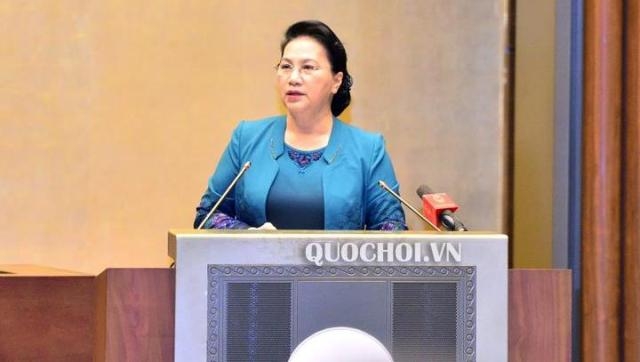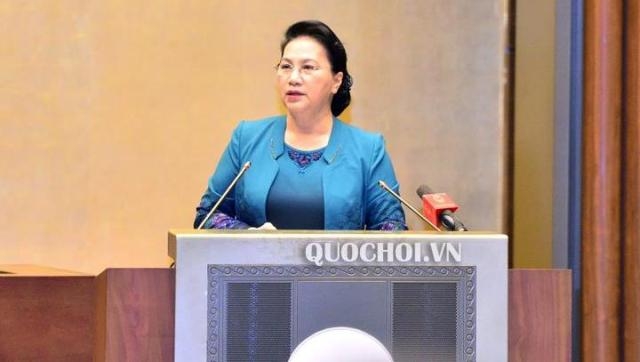
The Party Organisation of the National Assembly (NA) Office held a conference in Hanoi on July 16 to disseminate Resolution No.26-NQ/TW on building a contingent of personnel at all levels adopted by the seventh plenum of the 12th Party Central Committee.

NA Chairwoman Nguyen Thi Kim Ngan addressing the event (Photo:
quochoi.vn)
Speaking at the event, NA Chairwoman Nguyen Thi Kim Ngan, who is
also Secretary of the NA’s Party Delegation, described building a contingent of
personnel, especially of those at the strategic level, as the most important
and crucial task of the Party, and as such should be done regularly in a
cautious, scientific, and effective manner.
The resolution is especially important
to continue improving the leadership and fighting capacity of the Party, she
said, adding that the NA’s Party Delegation will devise a specific action plan
to implement the resolution.
The plan will focus on reviewing and
building legal documents, resolutions, and mechanisms regarding power control
and appraisal of trust, as well as improving training establishments to
discover and foster talent, Ngan said.
It will refine the legislature’s
supervision mechanism, including question and answer sessions, confidence vote
casting which will lay the foundation for personnel appraisal, as well as legal
regulations regarding the NA’s mission and authority over high-level personnel
work, the leader noted.
Further attention will be paid to
personnel building and work at the NA’s agencies, including assigning quotas
based on age, gender, and ethnic diversity in hiring officers and those
eligible to work in international environments, she added.
In the afternoon of the same day, the NA
Office’s Party Organisation disseminated the contents of Resolution
No.27-NQ/TW, dated May 21, 2018, on reforming salary policy for officials,
cadres, armed forces, and workers in enterprises; as well as Resolution
No.28-NQ/TW dated May 23, 2018, on reforming social insurance policy issued by
the 12th National Party Committee.
Source: NDO
In the spirit of "Party members go first, the people follow”, all households of Party members in the Doan Ket sub-region in Da Bac town, Da Bac district, voluntarily removed gates and fences, and donated land when the road expansion project passed through their properties. Inspired by their example, 68 households in the sub-region quickly followed suit, contributing over 1,400 sq.m of residential and perennial cropland to widen the main road through the residential area. The exemplary role of Party members in Doan Ket stands as a shining example of studying and following President Ho Chi Minh’s thought, morality, and lifestyle.
The Hoa Binh provincial People's Committee held a monthly meeting on May 29 to assess the implementation of socio-economic development tasks in the first six months of 2025, the progress of key projects, and some other important issues.
During his lifetime, President Ho Chi Minh always expressed his deep affection and special concern for children and youth. He once emphasized: "Caring for and educating children well is the responsibility of the entire Party and the entire people”; "First of all, the family (i.e. grandparents, parents, siblings) must do this job well”. "the Party Committees…, the Children’s Committee, the Youth Union, the education sector, and all related organizations must have specific plans to ensure children grow healthier and more progressive”. His teachings has been remaining valuable and serving as the guiding principles in the work of protecting, caring for, and educating children. In line with this ideology, Hoa Binh Province has continuously been prioritizing and investing resources in the well-being of children in recent years.
Mr. Nguyen Phi Long, the alternate Member of the Party Central Committee and Secretary of the Provincial Party Committee chaired the meeting of the Standing Committee of the Provincial Party Committee to provide opinions on several investment projects within the province. There was the attendance of Ms. Bui Thi Minh, the Permanent Deputy Secretary of the Provincial Party Committee and Chairwoman of the Provincial People’s Council; Mr. Bui Đuc Hinh, the Deputy Secretary of the Provincial Party Committee and Chairman of the Provincial People’s Committee and other members of the Standing Committee; the leaders from other departments, agencies, and some localities.
The Standing Board of the Vietnam Fatherland Front (VFF) Committee of Hoa Binh province held a meeting on May 28 to honour outstanding village elders, village heads, and reputable individuals from local ethnic minority and religious communities.
In mid-May, the provincial Museum organised an exhibition named "Duoi la co Dang Cong san Viet Nam quang vinh” (Under the flag of the glorious Communist Party of Vietnam). This meaningful activity took place in the joyful atmosphere to celebrate the country's major holidays and the Party congresses at all levels for the 2025-2030 term, towards the 14th National Party Congress.



